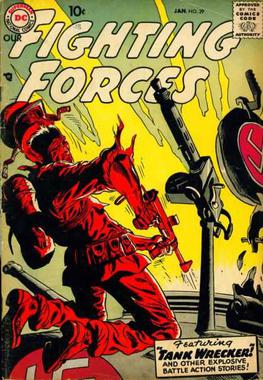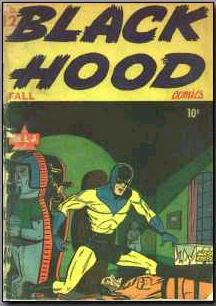Notable events of 1939 in comics.

Classics Illustrated is an American comic book/magazine series featuring adaptations of literary classics such as Les Misérables, Moby-Dick, Hamlet, and The Iliad. Created by Albert Kanter, the series began publication in 1941 and finished its first run in 1969, producing 169 issues. Following the series' demise, various companies reprinted its titles. Since then, the Classics Illustrated brand has been used to create new comic book adaptations. This series is different from the Great Illustrated Classics, which is an adaptation of the classics for young readers that includes illustrations, but is not in the comic book form.
Ace Comics was a comic book series published by David McKay Publications between 1937 and 1949 — starting just before the Golden Age of Comic Books. The title reprinted syndicated newspaper strips owned by King Features Syndicate, following the successful formula of a mix of adventure and humor strips introduced by McKay in their King Comics title in April 1936; some of the strips were transferred from King Comics and continued in Ace Comics from issue #1. Ace Comics #11, the first appearance of The Phantom, is regarded by many to be a key issue in the history of comics, as it introduced to the comics format one of the first of the costumed heroes, leading to the Golden Age of superheroes in comics.

Our Fighting Forces is a war comics anthology series published by DC Comics for 181 issues from 1954 to 1978.

Motion Picture Funnies Weekly is a 36-page American comic book created in 1939, and designed to be a promotional giveaway in movie theaters. While the idea proved unsuccessful, and only a handful of sample copies of issue #1 were printed, the periodical is historically important for introducing the enduring Marvel Comics character Namor the Sub-Mariner, created by writer-artist Bill Everett.

Tarzanesque is a term created by Frenchman Francis Lacassin used to describe characters in comic books inspired by Tarzan. A tarzanesque character resembles Tarzan in his physical resourcefulness, within a line of action that includes an adventurous life in the jungle, the gift of understanding and being understood by animals, contact with lost civilizations and courage combined with the ability to deal with nature. The creation of such characters may have been propitiated by the success that Tarzan had achieved since his appearance in literature in 1912, culminating with the release of daily comic strips in 1929, which paved the way for a genre that combined the allure of the unknown environment, the need for the archetypal characteristics of the hero and the popularity of access.

Black Hood Comics was the name of an American anthology comic book series published by MLJ Magazines Inc., more commonly known as MLJ Comics, for eleven issues between Winter 1943 and Summer 1946. The series featured MLJs costumed hero Black Hood, and "Boy Buddies", featuring Shield's partner 'Dusty the Boy Detective' and Wizard's side-kick 'Roy the Superboy', together with humor strips.

Blue Ribbon Comics is the name of two American comic book anthology series, the first published by the Archie Comics predecessor MLJ Magazines Inc., commonly known as MLJ Comics, from 1939 to 1942, during the Golden Age of Comic Books. The revival was the second comic published in the 1980s by Archie Comics under the Red Circle and Archie Adventure Series banners.

Magazine Enterprises was an American comic book company lasting from 1943 to 1958, which published primarily Western, humor, crime, adventure, and children's comics, with virtually no superheroes. It was founded by Vin Sullivan, an editor at Columbia Comics and before that the editor at National Allied Publications, the future DC Comics.
Black people have been portrayed in comics since the medium's beginning, with their portrayals often the subject of controversy. Mainstream comic publishing companies have had a historical trend of being predominantly white and male, reflecting the lack of representation and inaccurate depictions of Black people in comics. The integration of black characters in mainstream and superhero comics has endured various obstacles and challenges. Critics have noted that black men and women have historically often been portrayed as jungle or ghetto stereotypes, and as sidekicks as opposed to primary characters. Occiasionally, comic book creators would lampshade stereotypes, lack of representation and emphasize social injustices. In recent years, with the integration of more Black people in mainstream comic writing rooms as well as the creation of comics on digital platforms has changed the representation and portrayals of Black people in comics and has started to reflect the complexities of Black people across the diaspora.
Novelty Press was an American Golden Age comic-book publisher that operated from 1940 to 1949. It was the comic book imprint of Curtis Publishing Company, publisher of The Saturday Evening Post. Among Novelty's best-known and longest-running titles were the companion titles Blue Bolt and Target Comics.

The Philadelphia Record was a daily newspaper published in Philadelphia, Pennsylvania from 1877 until 1947. It became among the most circulated papers in the city and was at some points the circulation leader.

Top-Notch Comics is an American comic book anthology series that was published by MLJ Magazines Inc., more commonly known as MLJ Comics, during the 1930s and 1940s period known as the Golden Age of Comic Books. From issue #28 it was re-titled Top-Notch Laugh Comics.
The East Coast Black Age of Comics Convention (ECBACC) is the Philadelphia region's first black comic book convention, bringing together hundreds of comic book, science fiction, and fantasy creators, their colleagues, and their fans. The ECBACC is a 501 (c)(3) non-profit community-based organization focused on education, literacy and the arts. ECBACC, Inc. was founded in 2002 by Yumy Odom, a multidisciplinary educator, scientist and researcher affiliated with Temple University, and Maurice Waters.

Men of War is the name of several American comic book series published by DC Comics. For the most part, the series was a war comics anthology featuring fictional stories about the American military during World War II.

Orrin Cromwell Evans (1902–1971) was a pioneering African-American journalist and comic book publisher. Considered "the first black writer to cover general assignments for a mainstream white newspaper in the United States," he also published All-Negro Comics, the first known comics magazine written and drawn solely by African-American writers and artists.

Martin Luther King and the Montgomery Story is a 16-page comic book about Martin Luther King Jr., Rosa Parks, and the Montgomery bus boycott published in 1957 by the Fellowship of Reconciliation. It advocates the principles of nonviolence and provides a primer on nonviolent resistance.
All-Out War is an American war comics anthology series published by DC Comics from 1979 to 1980. It primarily featured characters created by writer Robert Kanigher with the Viking Commando being the lead feature.

Golden Legacy was the umbrella title for a line of educational Black history comic books published by Fitzgerald Publishing Co. from 1966 to 1976. Golden Legacy published comic book biographies of such notable figures as Toussaint Louverture, Harriet Tubman, Crispus Attucks, Benjamin Banneker, Matthew Henson, Alexandre Dumas, Frederick Douglass, Robert Smalls, Joseph Cinqué, Walter F. White, Roy Wilkins, Thurgood Marshall, Martin Luther King Jr., Alexander Pushkin, Lewis Howard Latimer, and Granville Woods.














